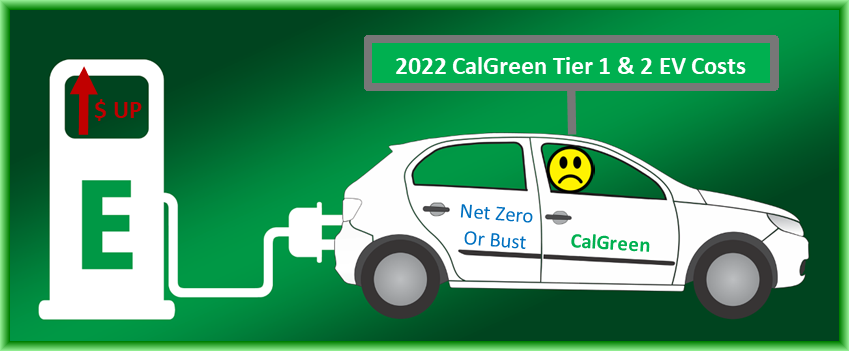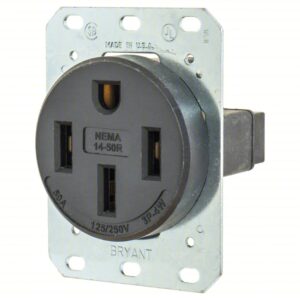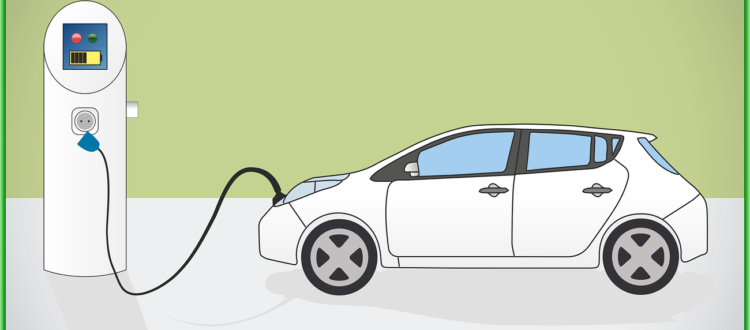2022 CalGreen Tier 1 and 2 EV Requirements
The 2022 CalGreen Tier 1 and 2 EV Requirements

The 2022 CalGreen Tier 1 and 2 EV requirements have changed. The requirements, and the associated costs to your project, have increased from the 2019 code.
Electric vehicles play an important role in California’s efforts to reach its ambitious climate and air quality goals. These vehicles, which produce zero tailpipe emissions, also play a critical role in reaching the state’s goal of getting 1.5 million zero-emission vehicles on California roads by 2025.
To see the current locations of EV chargers in California you can visit the website PlugShare.com.
Under the 2022 CalGreen Code, the electric vehicle charging requirements only apply to new projects. Remodels or additions are not required to comply.
The recent vote by the California Air Resources Board (CARB) bans the sale of new gasoline driven cars by 2035. The board’s new rules also would set interim quotas for zero-emission vehicles, focusing on new models. Starting in 2026, 35% of new cars, SUVs and small pickups sold in California would be required to be zero-emission vehicles. That would increase each year, and is expected to reach 51% of all new car sales in 2028, 68% in 2030 and 100% in 2035. The quotas also would allow 20% of zero-emission cars sold to be plug-in hybrids.
California will need an additional 1.2 million chargers to meet the needs of an all-electric new vehicle requirement.
Understanding the Code Terminology

The electric vehicle industry uses some unique terms to describe the various components and systems. The following definitions will help understand the intent of the 2022 CalGreen Code.
EV Capable Space:
A vehicle space with electrical panel space and load capacity to support a branch circuit and necessary raceways, both underground and/or surface mounted, to support EV charging.
EV Ready Space:
A vehicle space which is provided with a branch circuit; any necessary raceways, both underground and/or surface mounted; to accommodate EV charging, terminating in a receptacle or a charger. An EV ready circuit can be a standard 120 volt receptacle for plug-in by a charger typically provided by the vehicle manufacturer. This chargers much slower than a Level 2 EVSE charging circuit which runs at 208/240 volt.
Low Power Level 2 EV Charging Receptacle:
A 208/240 Volt 20-ampere minimum branch circuit and a receptacle for use by an EV driver to charge their electric vehicle or hybrid electric vehicle.
Level 2 EV Supply Equipment (EVSE):
The 208/240 Volt 40-ampere branch circuit, and the electric vehicle charging connectors, attachment plugs, and all
other fittings, devices, power outlets, or apparatus installed specifically for the purpose of transferring energy between the premises and the electric vehicle. Note that there are multiple types of 240 volt receptacles, depending on the rated amperage. The 40 amp rated receptacle required by the CalGreen Code is a NEMA 14-50R. This receptacle looks like this:

Direct Current Fast Chargers (DCFC): Direct current fast charging provides DC power straight to your EV’s battery. The AC-to-DC conversion happens in the charging station before the electrons enter your vehicle. That’s why DC fast charging is able to provide a much faster charge than Level 1 or Level 2 charging. A DCFC charger provides up to 10 times faster charging than a Level 2 EVSE charger. A Tesla Supercharger is an example of a DCFC.

Tesla DCFC EV Supercharger
2022 CalGreen Code Residential Tier 1 & 2 EV Charging Requirements
One and Two Family Dwelling Units
CG A4.106.8.1. Tier 1 and Tier 2. For each dwelling unit, a dedicated 208/240-volt branch circuit (Level 2 EVSE) shall be installed in the raceway required by Section 4.106.4.1. The branch circuit and associated overcurrent protective device shall
be rated at 40 amperes minimum.
Analysis: So, this is pretty clear and has not changed from the 2019 code. Instead of an EV rough-in only, as required by the mandatory measures, Tier 1 and Tier 2 projects must install a complete EV charging circuit and receptacle. The circuit must be 208/240 volt, 40 amp rated, with a EV charging receptacle and ready to charge. Of course, the complete installation must be in accordance with the California Electrical Code.
New Multi-family Development Projects and Hotels and Motels
CG A4.106.8.2.1. Tier 1 EV Ready. Thirty-five (35) percent of the total number of parking spaces shall be equipped with low power Level 2 EV charging receptacles. For multifamily parking facilities, no more than one receptacle is required per dwelling unit when more than one parking space is provided for use by a single dwelling unit.
EV Chargers for projects with 20 or more dwelling units, sleeping units or guest rooms. Ten (10) percent of the total number of parking spaces shall be equipped with Level 2 EVSE. Where common use parking is provided, at least one EV charger shall be located in the common use parking area and shall be available for use by all residents or guests.
Analysis: If your multifamily, hotel or motel project has less than 20 dwelling units you must provide 35% of the parking spaces as EV Ready. An EV Ready circuit must be a complete system terminating in a 120 volt receptacle. If desired, a Level 2 EVSE would also meet this requirement but would be more costly to install.
If your project has 20 or more dwelling units, then 10% of the parking spaces must be provided with Level 2 EVSE chargers. A Level 2 EVSE charger requires a 208/240 volt, 40 amp circuit.
Note: The code does not make it clear if this in addition to the 35% EV ready spaces. Or if it’s instead of the 35% EV Ready spaces. Also, if it’s “in addition to”, does the Level 2 EVSE stations count towards the EV Ready requirements? Or are they additive? This is very poorly written and hopefully the California Energy Commission will clarify this. The literal interpretation is that this is “in addition to”, and the Level 2 EVSE outlets do not count towards the EV Ready requirements. So, a 100 unit motel would require (35) EV ready receptacles plus another (10) Level 2 EV charging receptacles. This would result in a whopping 1800 amp (45 outlets at 40 amps each) electrical demand load! For the sake of exactitude, the electrical load would be 1400 amps at 120 volt and 400 amps at 240 volt. To put this in perspective, I recently worked on an (87) unit hotel in Redding, California. The electrical service to the site was 2000 amps. If this were in a Tier 2 jurisdiction the new CalGreen requirements would require a significant increase in the electrical service to the building.
CG A4.106.8.2.1. Tier 2 EV Ready. Forty (40) percent of the total number of parking spaces shall be equipped with low power Level 2 EV charging receptacles. For multifamily parking facilities, no more than one receptacle is required per dwelling unit when more than one parking space is provided for use by a single dwelling unit.
EV Chargers for projects with 20 or more dwelling units, sleeping units or guest rooms. Fifteen (15) percent of the total number of parking spaces shall be equipped with Level 2 EVSE. Where common use parking is provided, at least
one EV charger shall be located in the common use parking area and shall be available for use by all residents or guests.
Analysis: If your multifamily, hotel or motel project has less than 20 dwelling units you must provide 40% of the parking spaces as EV Ready. An EV Ready circuit must be a complete system terminating in a 120 volt receptacle. If desired, a Level 2 EVSE would also meet this requirement but would be more costly to install.
If your project has 20 or more dwelling units, then 15% of the parking spaces must be provided with Level 2 EVSE chargers. A Level 2 EVSE charger requires a 208/240 volt, 40 amp circuit.
2022 CalGreen Code Non-Residential Tier 1 & 2 EV Charging Requirements
The nonresidential Tier 1 and Tier 2 requirements begin on page 142, of Appendix A5.3. As in the residential requirements, these only apply to new construction. Additions or remodels do not have to comply with these requirements. The only exception would be if your local jurisdiction has adopted a local amendment to include additions or remodels.
CG A5.106.5.3.1. Tier 1. Table A5.106.5.3.1 shall be used to determine the number of EV capable spaces required. Refer to Section 5.106.5.3 for design space requirements.
When EV capable spaces are provided with EVSE to create EVCS per Table A5.106.5.3.1, refer to Section 5.106.5.3.2 for the allowed use of Level 2 or Direct Current Fast Charger (DCFC) and Section 5.106.5.3.3 for the allowed use of Automatic Load Management Systems (ALMS).

NonResidential Tier 1 Charging Requirements
This section is completely revised from the 2019 code. It provides one table for Tier 1 requirements and a separate table for he Tier 2 requirements.
The Tier 1 requirements shown in the above table include both EV Capable (rough-in for future) and EVSE (installed) quantities.
Analysis: The table is self-explanatory in terms of the requirements.
If your project had 100 parking spaces (of all kinds) you would need to provide 17 EV capable and 9 EVSE spaces. The 17 represents the 26 EV capable spaces minus the 9 EVSE spaces (26-9=17), as per note 2.
It is interesting to note that the nonresidential requirements are actually less than the residential requirements (as high as 30% as opposed to 35% for all residential projects). In addition, the notes at the bottom of the table clarifies two items that were unclear in the residential requirements.
Note 1 shows that space requirements should be rounded up to the nearest whole number for projects with 201 or more parking spaces.
Note 2 clarifies that the number of required EVCS count towards the total number of EV capable spaces required.
CG A5.106.5.3.2. Tier 2. Table A5.106.5.3.2 shall be used to determine the number of EV capable spaces required. Refer to Section 5.106.5.3 for design requirements. When EV capable spaces are provided with EVSE to create EVCS per Table A5.106.5.3.1, refer to Section 5.106.5.3.2 for the allowed use of Level 2 or Direct Current Fast Charger (DCFC) and Section 5.106.5.3.3 for the allowed use of Automatic Load Management Systems (ALMS).

NonResidential Tier 2 Charging Requirements
Analysis: This table is also self-explanatory in terms of the requirements. The Tier 2 mandates that 45% of projects with 201 or more parking spaces shall be EV capable (rough-in for future) and 33% be EV capable (installed).
If your project had 100 parking spaces (of all kinds) you would need to provide 27 EV capable and 13 EVSE spaces. The 27 represents the 40 EV capable spaces minus the 13 EVSE spaces (40-13=27), as per note 2.
Summary
The 2022 CalGreen Code Tier 1 and Tier 2 EV charging requirements are a huge step forward in the progress of the electric vehicle movement. It will further the transition from harmful combustion engines and towards a cleaner (and quieter!) future. However, the cost for these changes are not insignificant. The greatest impact will be to the electrical service size and the systems necessary to provide for the high-demand electrical loads presented by these chargers.
The impact on all new nonresidential projects will be significant in terms of capital cost. It will be important for the architect and engineering design teams to get these requirements into the project budget early in the schematic design phase. This will avoid any budget disconnects or surprises for the building owner.

Please Note:
Those who have worked with me, or have read information on my website, know that I am always happy to share my knowledge on the CalGreen Code. However, the EV charging requirements have created such a flood of information requests, that it is negatively affecting my business. I can no longer accept inquiries on the EV charging requirements of the CalGreen Code. Nor do I wish to act as a consultant on this subject.
If you have questions on this code I suggest you try calling the California Energy Commission, Building Energy Efficiency Standards, at 800-772-3300. Or you can email them at title24@energy.ca.gov.
Gary Welch


Gary Welch has over 35 years experience in the field of sustainable building design. He is the CEO of CalGreen Energy Services. Gary is an ICC Certified CalGreen Special Inspector and Plans Examiner.

